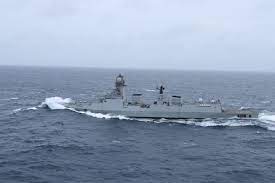
The Indian Navy announced that two of its indigenously built warships, INS Sahyadri and INS Kolkata, are set to participate in the 10-day Malabar exercise alongside the navies of the United States, Japan, and Australia. The exercise, known for its increasing scope and complexity since its inception as a bilateral naval drill between India and the US in 1992, will begin off the Sydney coast and is being hosted by the Royal Australian Navy for the first time.
The Malabar exercise will be conducted in two phases – the harbour phase and the sea phase. The harbour phase includes cross-deck visits, professional exchanges, sports fixtures, and planning interactions, while the sea phase will involve intricate exercises in anti-surface, anti-air, and anti-submarine warfare domains, including live weapon firing drills. The participation of an Indian Navy P-8I submarine hunter plane will further enhance the exercise’s complexity.
The Indian warships, equipped with modern weapons and sensors for surface, air, and underwater threat detection, will demonstrate interoperability and learn from maritime security operations best practices of partner nations. The Malabar drills have historically evolved, with aircraft carriers from India and the US Navy operating together for the first time in 2005, and the inclusion of the Japanese Maritime Self Defence Force in 2014, followed by Australia in 2020.
China has been closely monitoring the activities of the Quad navies under the Malabar banner, as the United States, India, Australia, and Japan upgraded the Quad forum to the ministerial level in 2019. The ongoing exercise emphasizes the maritime cooperation and readiness of these nations in the Indo-Pacific region.
The Malabar exercise exemplifies the commitment of these Quad nations to enhancing regional security and strengthening their collaborative efforts in maintaining peace and stability in the Indo-Pacific area.
Sources By Agencies




